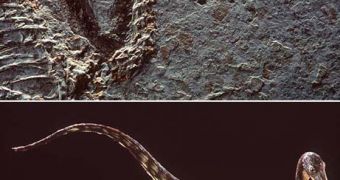The common theory says that dinosaurs had feathers and birds originated from feathered dinosaurs.
The oldest feathered dinosaur is considered the 140-million-year-old turkey-sized Sinosauropteryx. Scientists considered the distinctive patterns encountered on the skin of a Sinosauropteryx ("Chinese lizard wing") fossil to be remnants of downy protofeathers. But a group of researchers rejects this and considers this dinosaur was nude and the patterns present "structural fibers, probably collagen-the most abundant fiber in vertebrates-of the skin and the dorsal frill," as lead study author Theagarten Lingham-Soliar of the University of KwaZulu-Natal in South Africa suggests.
His team is on the side of a small group of scientists who claim there's no evidence of dinosaurs ever having feathers.
"The existence of protofeathers in these dinosaurs was considered critical evidence that birds were derived from dinosaurs," said study co-author Alan Feduccia, a bird evolution expert at the University of North Carolina at Chapel Hill.
"What we have shown is that there's absolutely no evidence whatsoever that protofeathers existed in dinosaurs, period." But most experts in this field are not convinced.
"These people have been flogging the same horse for a long time," said Kevin Padian, curator of the University of California Museum of Paleontology.
The protofeathers were found on an individual dug in 1996 in Liaoning Province (northeastern China).
"Such finds have firmly established the link between dinosaurs and birds," said Mark Norell, the paleontology chair at the American Museum of Natural History in New York, who has co-authored several papers about feathers in other dinosaur fossils.
"There's a preponderance of evidence supporting the idea that birds are nested within theropod dinosaurs," he said.
Therapods, the carnivorous dinosaurs that included Tyrannosaurus rex, have many traits in common with the birds. Common theory says that theropods developed feathers to keep warm and tree life pushed them to flight. But the opponents to this theory say that birds evolved earlier from a common ancestor with dinosaurs, and no dinosaur grew feathers.
In the new study, they investigated a recently discovered Sinosauropteryx fossil encountered also in Liaoning.
"The peripheral dorsal structures are the remains of fiber reinforcement of the frill that extended from the head to the tip of the tail of the dinosaur. Their regular nature and straightness defies the notion of them being soft pliable structures [like feathers] but rather high-tensile fibers such as collagen. The fibers show a striking similarity to the collagen found on the skin of sharks and reptiles today," said Lingham-Soliar.
No protofeathers in Sinosauropteryx is used by these researchers to cancel the theory of dinosaurs evolving feathers.
"Scientists need to better understand how soft tissues in well-preserved dinosaurs are actually fossilized. But the new study falls short because it relies only on microscopic analysis, with no additional CAT scans or chemical tests. They merely looked at the tissues and said, Oh, they're straight and well organized ? it must be collagen," said David Unwin, a vertebrate paleontologist at the University of Leicester in England, who considers himself neutral on the subject.
"In some cases, the fibers do look like collagen. But what they didn't draw attention to is that there are other tissues in there that don't look like collagen and might be protofeathers."
Another weak point of the concept: what about the many other feathered dinosaur genera?
"These creatures are actually descendants of birds that lost their ability to fly. When they become flightless, they superficially resemble small dinosaurs," said Feduccia.
"To be brutally honest, the contrarian views on this issue haven't been particularly strong. I don't know if they have really helped shape our ideas about the origin of birds in any serious way. One way the [latest] paper may be significant, though, is that it suggests that the story of the origin of feathers may not be quite as simple as we would like to have it." Unwin added.

 14 DAY TRIAL //
14 DAY TRIAL //